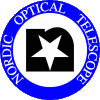
Disentagling the optical emission mechanisms in tidal disruption eventsP72-010 Koljonen
Summary:Tidal disruption events (TDEs) are ideal targets to probe the formation of accretion disks and accompanying outflows. Multiwavelength observations of TDEs have revealed a surprisingly diverse population. Especially, the so-called optical TDEs have shown late-time X-ray and radio emission years after the optical peak emission indicating delayed accretion disk formation and long timescales for the circularization process. Therefore, the origin of the prompt optical emission of these events remains unclear. Here, we propose imaging polarimetry of tidal disruption events to understand the location and properties of the optical emission and subsequently the formation process of the accretion disk around supermassive black holes. ***
CalibrationsInternal flats, arcs and bias frames from alfosc-calibsObservationsOur immediate objective is to follow the polarization evolution of optically bright TDEs. Observations should be done in 2-3 weeks cadence (8 in total for one target). For each observation, we require linear polarimetric observations in two different filters (Bessel V and R) using the standard ALFOSC setup. Please, make sure to center the target in the image. The PI will send the target and observing information using the OB generator when this ToO is triggered (2 triggers/targets in total).Available scriptsGo to the directorycd ~/scripts/72-010 execute the requested scripts.
The above information is collected from the ToO/Mon reports that have been created by the observer. Should any of the observations have been carried out using the OB system, you will find additional information HERE |
|||||||||||||||||||||||||||||||||||||||||||||||||||||||||||||||||||||||||||||||||||||
| |||||||||||||||||||||||||||||||||||||||||||||||||||||||||||||||||||||||||||||||||||||